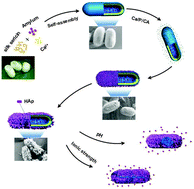Silk sericin microcapsules with hydroxyapatite shells: protection and modification of organic microcapsules by biomimetic mineralization†
Abstract
Silk protein sericin based organic–inorganic hybrid microcapsules are fabricated by incubating sericin microcapsules with a supersaturated calcium phosphate solution containing citric acid. A mineral hydroxyapatite shell is formed on the surface of the microcapsules. The thickness of the mineralized shell is dependant on the mineralization time. The amylum as a model cargo is encapsulated into the microcapsules with/without the presence of a mineralized shell. The release behavior of amylum from the microcapsules is investigated under different external environments. The results show that the release speed of amylum from the hybrid microcapsules is slower than from the sericin microcapsules under different pH and ionic strength conditions. This indicates that the stability of the hybrid microcapsules is improved due to the presence of the hydroxyapatite shell. The mineral shell provides a good protection to the microcapsule structure and carries goods against external harsh environment. In addition, cell cultures show a good cytocompatibility of the hybrid microcapsules. The natural microcapsules having an inorganic mineral shell cover may potentially act as drug delivery and encapsulating bioactive molecule systems.


 Please wait while we load your content...
Please wait while we load your content...